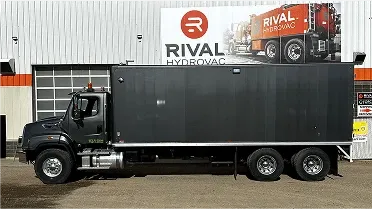Interested in this vehicle?
Contact Summit

At Summit Truck Equipment, we specialize in Rival and Foremost equipmentalong with many other great Hydrovac brands. We proudly serve a large areasurrounding both Ontario and Alberta, Canada.
Summit is the exclusive dealer of the Foremost hydrovac line. These trucks include the extensive line of Foremost conventional hydrovacs, as well as the complete line of Rival hydrovacs, trucks designed to transport full debris loads on roadways. Our experienced sales staff will be able to assist in identifying the unit most suitable to each company's intended use and application.

Shop Rebel, Brooks Septic and All Metal Manufacturing Units

Shop Various Sizes of Insulated and Heated Box Trucks from Industry Leading Intercontinental Truck Bodies

Professionals you can count on to help you find the parts you need. Shop at a location or online.

We’re proud to provide specialized services for vacuum, hydrovac, and other commercial trucks of all types, makes, and sizes.
Fast and tailored commercial vehicle and equipment financing to fit your needs and budget fromour trusted lenders.


5
at Summit of Bradford, ON
New Hydrovac

36,000 GVWR

Diesel


4
at Summit of Bradford, ON
New Hydrovac

36,000 GVWR

Diesel


5
at Summit of Red Deer, AB
New Hydrovac

32,100 GVWR

Diesel


5
at Summit of Red Deer, AB
New Service Truck

11,995 GVWR

Diesel

35 Miles


6
at Summit of Red Deer, AB
New Septic Truck

24,300 GVWR

Diesel


6
at Summit of Red Deer, AB
Used Water Truck

24,300 GVWR

Diesel

22,006 Miles


4
at Summit of Bradford, ON
New Hydrovac

24,300 GVWR

Diesel


7
at Summit of Red Deer, AB
New Water Truck

32,100 GVWR

Diesel

Rent a hydrovac with the goal of eventually owning it.
Tough, high-quality hydrovac and other specialty trucks from Rival, Foremost, and more, paired with our Western Star and Freightliner chassis to maximize your investments.
With expertise in legal regulations and environmental variations across North America, our salespeople are here to help you find the best fit for your region and business needs. With hydrovac trucks and more, available to purchase, finance, or as long-term rentals, Summit makes it easier than ever to get digging.
Deciding between renting and purchasing a hydrovac truck depends on each business’s particular needs. Our team members can help you calculate the cost differences and discuss aspects of your decision such as the payback period, maintenance costs, and projected long-term use in the field. Having all these details in front of you will make the decision much easier.
Deciding between renting and purchasing a ruck depends on each business’s particular needs. Our team members can help you calculate the cost differences and discuss aspects of your decision, such as the payback period, maintenance costs, and projected long-term use in the field. Having all these details in front of you will make the decision much easier.
Non-code vacuum trucks are not rated to carry hazardous materials, while other vacuum trucks are. There are multiple use cases for each, depending on your excavation, transport, and storage needs.
Box trucks range from 10 to 26 feet in length, with varying weight and carrying capacities.
Though it depends on usage, daily inspections and weekly hose checks should minimize the frequency of servicing.
Vacuum trucks use high-powered vacuum systems to suction debris into a storage tank for transport and disposal, while hydrovac trucks use high-pressure water to break up soil in addition to a vacuum system for removal and storage.
The people at this business care about their customers the exceptional service I always get from summit is #1.
The stars don’t justify how I feel. Excellent craftsmanship. I recommend this company and will remember my experience next time I need anything related to their expertise.
The team is knowledgeable, professional, and goes above and beyond to ensure everything runs smoothly.
Transparency
Quality
Integrity
At Summit Truck Equipment, we specialize in Rival and Foremost equipment along with other truck types in the construction industry such as water, vacuum, insulated van, service and code vocuum trucks. We are happy to provide mobile and in shop services including repairs, scheduled maintenance and warranty campaigns.
With a large supply of parts and equipment in stock, we proudly serve a large area surrounding both Ontario and Alberta, Canada. We’re excited to offer pick up or delivery options for our valued customers. Training and Demonstrations are available on all of our units!
Tips and trends to help you get the most out of your Truck

Hydrovac vs traditional excavation: find the method that suits you best Excavation, or digging, is an essential part of installing utilities and developing infrastructure. Though this task is...

When taking on tough jobs, it helps to have strong, durable equipment that you can rely on. Excavation, or the removal of soil and rock from an area, is an essential component of many construction job...

Most people are familiar with garbage, tow, and pickup trucks, but these aren’t the only trucks that deserve their day in the sun! Hydrovacs, a lesser-known but useful vehicle, serve multiple pu...

Let’s face it, digging isn’t always glamorous. But it is risky, especially when what you can’t see is underground and could blow a fuse, crack a pipe, or worse. Hydrovac excavation...

Buying a hydrovac truck is a big investment, but it doesn’t have to be a headache. With the right financing plan, you can make a budget-friendly move while putting your new high-end, powerful eq...
Contact Summit